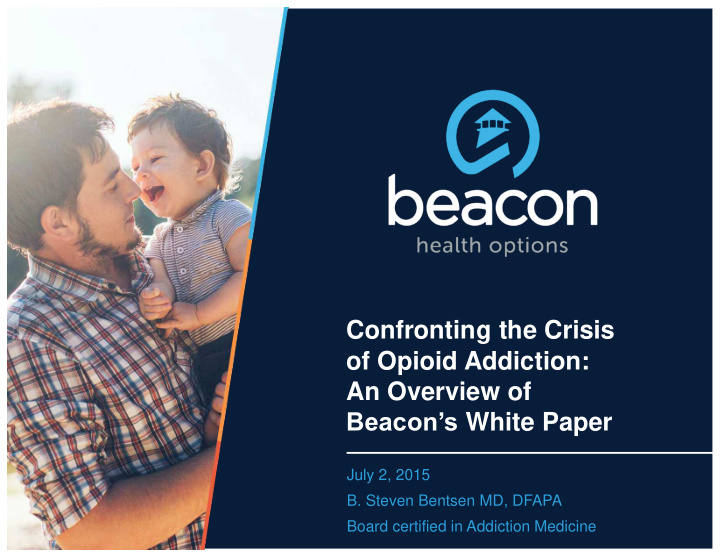



Confronting the Crisis of Opioid Addiction: An Overview of Beacon’s White Paper July 2, 2015 B. Steven Bentsen MD, DFAPA Board certified in Addiction Medicine
Opioid Addiction Is Headline News Why? There has been massive overprescribing of opioid painkillers Heroin abuse is growing Treatment is fragmented and hard to access Deaths from opioids outnumber deaths from motor vehicle accidents per annum 2
Drug-poisoning Deaths Involving Heroin: United States, 2000 – 2013 * 3
Issues Unique to Addiction Treatment Widest gap between science and clinical practice About 50 percent of family members would help a family member obtain treatment About 5 percent of treatment referrals are from health care providers Forty-four (44) percent of referrals from legal system Most do not receive best practice care Only minority of states monitor treatment outcomes Quality measures not standardized Many programs exempt from state regulation or medical oversight 4
Medication-assisted Treatment (MAT) Reduces All-cause Mortality “…the all -cause mortality rate for patients receiving methadone maintenance treatment was similar to the mortality rate for the general population, whereas the mortality rate of untreated individuals using heroin was Receiving Untreated more than 15 times treatment higher.” Modesto-Lowe et al., 2010; Gibson, 2008; Mattick, 2003; Bell and Zador, 2000; Marsch, 1998 5
MAT as Part of Treatment Program Four approved medications for treatment of opiate dependency: • Buprenorphine • Methadone • Naltrexone oral • Naltrexone injectable MAT is an evidence-based treatment for opioid addiction; however, it is not a stand-alone treatment choice. MAT has proven to be very effective as part of a holistic, evidence-based treatment program that includes behavioral, cognitive and other recovery-oriented interventions, treatment agreements, urine toxicology screens and checking of PDMP. 6
Opioid Addiction: A Chronic Illness Should Be Treated Through Chronic Disease Model Recommended Interventions Description • Make naloxone widely available • Remove barriers to non-acute provider capacity: Increase community • Methadone, Suboxone resources and policies • Extenders - mid-level administrators under supervision • Public awareness campaign targeting citizens, prescribers & policymakers about the chronic disease model • Encourage bundled payments for high-quality providers to encourage community care instead Increase collaboration of institutional care: between payers and • Peers, office and home-based formats providers • De-stigmatize long-term treatment options. More than just abstinence Improve access to • Promote verbal and written explanation of treatment options, alternatives, risks and benefits, resources for including Medication-Assisted Therapies (MAT) self management - • Re-unify the system of care (e.g. Department of Health carve-outs) in accordance with ASAM Improve design of criteria delivery system • Require case/care management/pain management services to be part of full-service addictions treatment • Apply evidence-based clinical practice guidelines to MAT, including real time support for Increase decision support prescribers (e.g. expert staffed support hotline for prescribers treating addictions) • Registries Implement clinical • Implement EHR technology to ensure real-time access to pertinent clinical information (i.e., information systems diagnoses, co-morbidities, medications, treatment goals) • Clear interpretation that SA-related personal health information will not be used for prosecutorial purposes 7
Summary 1. Prescription opioid addiction has reached crisis proportions. 2. Social bias and a pervasive view of addiction as a moral failing has limited access to effective, evidence-based treatments. 3. Implementing the six tenets of the chronic disease model of care signifies a major redesign of the current health care system to appropriately treat the chronic disease of opioid addiction and combat the opioid crisis. 4. As the path to addiction often begins with prescribed opioids for the treatment of pain, a comprehensive treatment continuum needs to include pain management. 5. Legislation could be instrumental in realizing this goal. 8
Thank you For questions submitquestions@beaconhealthoptions.com 9
Recommend
More recommend